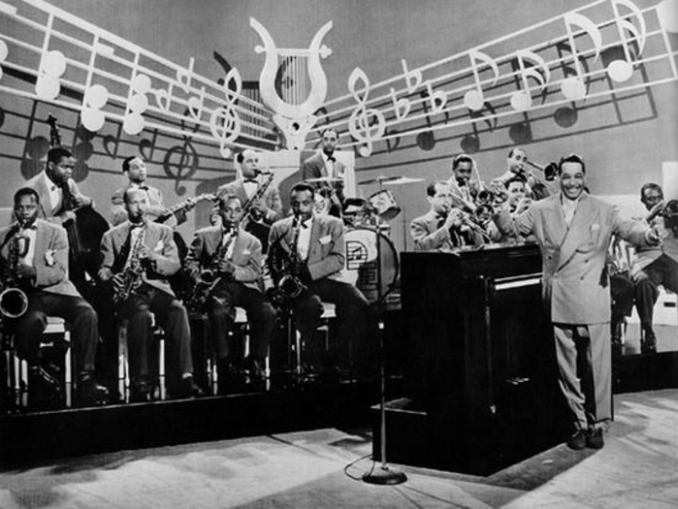
The earliest ancestor of the modern music video was the soundie, a black-and-white 16mm film recording of a musician performing before a live audience. The first soundies appeared in 1940, and all the big singing stars and bandleaders recorded them: Bing Crosby, Cab Calloway, Duke Ellington, even Lawrence Welk. Eight to ten three-minute soundies from different artists fit on a single film reel, which would be sent to diners, bars, and nightclubs all over the country. Patrons could drop a dime in a Panoram – a video jukebox with a small viewing screen – and watch a soundie.
There were a few problems though: Viewers couldn’t choose which video they wanted to see (the way they could choose songs in a jukebox) because the reel just ran continuously. Other issues were technical: The reels didn’t last very long and the Panoram’s mechanics were unreliable – often, the reel wouldn’t slip into the correct playing position and would instead be thrown off balance inside the machine. Then a repairman had to be called in to fix it.
But it was the advent of television after World War II that really led to the decline of soundies. With musical variety shows like The Ed Sullivan Show playing for free, why would anyone waste a dime on a Panoram? By the mid-1960s, bands like the Beatles and the Rolling Stones had begun producing film clips of their songs to promote their albums. Most of these early videos aired on music TV shows like Shindig and Hullabaloo. But it would be another 30 years before music videos got their own TV station.

In 1977 a cable system called Qube debuted in Ohio. Among its 30 channels, Qube had several unique ones: Star, which would go on to become The Movie Channel; Pinwheel which would become Nickelodeon, and Sight on Sound, which featured concert footage and other types of music programming.
A former disc jockey and radio program director for New York’s WNBC, Bob Pittman, noticed how popular Qube was in its local market and used some of Qubes concepts on a local New York TV show called Album Tracks. In 1979 he got a job with the Warner Satellite Entertainment Company, and the following year he pitched the idea of a station that aired videos produced by record companies.
Warner execs loved the idea and gave him the green light, and on August 21, 1981, at one minute past midnight, MTV debuted. It was a good deal for Warner: The record companies provided the videos at their own cost, so the station’s content was basically free. The first video: the Buggles’ “Video Killed the Radio Star.”
At that time, the station only had about 125 videos, but within months, MTV was the most-watched cable network that Warner owned. For his part, Pittman pushed hard to make the station unique. His target audience was under 30, so he hired flashy design houses to create ads to appeal to those viewers. He also wanted the station’s IDs to be unique; Pittman felt that viewers should never turn to MTV and confused about what they were watching.
The result: in every market where MTV was shown, record sales went up. Stores reported that albums by groups like Duran Duran and the Stray Cats – artists with limited radio play – were flying off shelves simply because their videos were on MTV. In markets where MTV wasn’t available, Pittman ran ads urging viewers to call their cable companies and say “I want my MTV!” Thousands of fans did just that, and by 1983, MTV was available in most areas from New York to Los Angeles.
As MTV’s popularity and viewership increased, critics began to attack it. In particular, they slammed MTV for excluding African American artists. The station shot back, saying that its rock music format wasn’t compatible with funk, R&B, or rap – in other words, with the stereotypical black music styles. The argument continued until 1982, when Michael Jackson’s Thriller album hit record stores. His record company, CBS, demanded that MTV show Jackson’s “Billie Jean” video. If it didn’t, CBS would pull all of its videos – which made up 25% of MTV’s programming. MTV caved. “Billie Jean” became a #1 hit and was the first video by an African American artist to air on MTV.
It wasn’t long before MTV had competition. Country Music Television launched in 1983, and many other imitators, like Cable Music Channel (CMC), hit the airwaves. Most fizzled, but commercial TV began to pay attention to videos too. Shows like Friday Night Videos (on NBC) and Night Tracks (on WTBS) ran for years. MTV responded by demanding exclusive rights to videos from the record companies, and in most cases, it got them. These exclusive contracts soon turned MTV into the major player in video distribution.
Initially, MTV’s primary demographic was young people. To attract an older audience, MTV launched VH1 in 1985. The station also began tweaking its own all-music format to hold on to younger viewers. By 1987, music videos were interspersed with programs like the game show Remote Control and Weird Al Yankovic’s AL-TV, which aired song parodies. At about the same time, MTV Europe, MTV Australia, and MTV Japan debuted. MTV India and MTV Asia followed in the 1990s, and MTV Internacional, a weekly show, expanded into MTV Latin America.
Today, your chances of stumbling onto a video when you turn to MTV are slim. Sitcoms, reality shows, dramas, and celebrity news rule. You want videos? Go to YouTube.

Be the first to comment